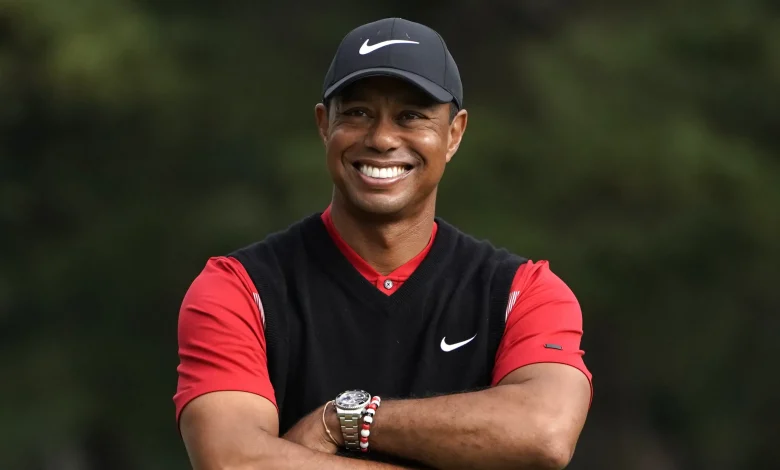Tiger Woods Battles Back Injury Again: Can He Ever Return to Championship Form?

Few names in the world of sports carry the same weight, admiration, and legacy as Tiger Woods. For nearly three decades, Woods has been the face of modern golf—redefining not only the way the sport is played but also how it is perceived by the public. His meteoric rise from prodigy to global icon, his dominance on the course, and his incredible comebacks from adversity have made him one of the most compelling figures in sports history.
Yet once again, the golf legend finds himself at a crossroads. Tiger Woods is battling another back injury, reigniting concerns about his future in professional golf. Fans, analysts, and fellow golfers alike are asking the same question: Can Tiger ever return to championship form?
The history of Woods’ injuries, the toll they’ve taken on his body and career, and the realistic prospects of another comeback from one of the most resilient athletes of all time.
The Long Road of Greatness—and Pain
Tiger Woods’ dominance on the PGA Tour is the stuff of legend. With 82 PGA Tour victories, tied for the most in history, and 15 major championships, second only to Jack Nicklaus, Woods’ record speaks for itself. However, behind this staggering success lies a career plagued by chronic injuries—particularly to his back.
Woods’ physical troubles began as early as the late 2000s. In 2008, despite suffering from a torn ACL and stress fractures in his leg, he famously won the U.S. Open at Torrey Pines in a playoff—a performance many consider one of the greatest displays of grit in sports history. But that victory also marked the beginning of an injury saga that would follow him for the next 15 years.
A History of Back Surgeries
Tiger’s back issues first became public in 2014, when he underwent a microdiscectomy to relieve pressure on a pinched nerve. It seemed like a minor setback at the time, but it was just the start. He would go on to have multiple back surgeries, including a spinal fusion in 2017, a procedure that fused vertebrae in his lower spine to reduce pain and improve stability.
That surgery seemed to be a turning point. In 2019, against all odds, Woods staged a comeback for the ages—winning the Masters Tournament at Augusta National. It was his first major title in over a decade and one that silenced critics who had written him off. The image of Woods hugging his children after that victory remains one of the most emotional moments in modern sports.
But as history has shown, the human body—no matter how strong or disciplined—can only endure so much. Woods’ back problems resurfaced after that triumphant moment, and each attempt to return to form has been met with physical setbacks.
The Latest Setback: A Familiar Struggle
Fast forward to the present day, and Tiger Woods once again finds himself sidelined with a back injury. His appearances in recent tournaments have been limited, and his physical discomfort has been evident. At times, he has appeared stiff during swings, occasionally wincing in pain after powerful drives. Reports suggest that his lower back continues to cause problems, making it difficult for him to play full rounds without discomfort.
In interviews, Woods has remained typically stoic, acknowledging the pain but refusing to make excuses. “I can still hit the shots,” he’s said. “It’s just about managing my body and making sure I can walk and recover.”
For a golfer who has built his career on precision, mental toughness, and physical strength, this latest injury raises serious questions: Can his body handle the demands of professional golf anymore?
Understanding the Physical Toll
To understand Tiger’s situation, it’s essential to recognize the biomechanics of golf. The sport may not appear as physically punishing as football or basketball, but the golf swing is an extremely complex, high-torque motion that places enormous stress on the lower back, hips, and knees.
Every swing involves rapid rotational forces—especially the explosive movements that generate Tiger’s legendary power. Over time, this can lead to disc degeneration, nerve compression, and chronic inflammation in the spine.
Dr. Andrew Hecht, a spine specialist who has worked with professional athletes, explains, “A spinal fusion can help stabilize the spine, but it also transfers stress to other areas. That means new problems can develop over time, particularly in the joints and muscles that compensate for the fused segment.”
In other words, even though Woods’ fusion surgery initially allowed him to return to play, it also created long-term biomechanical challenges that continue to affect his movement.
Tiger’s Resilience: The Blueprint of a Champion
If there’s one thing fans have learned about Tiger Woods, it’s that he refuses to quit. Time and again, he has defied expectations and battled back from both personal and physical hardships.
After his 2017 spinal fusion, most experts believed his career was over. Yet two years later, he not only returned to competition but also captured golf’s most coveted prize. That comeback became a testament to his perseverance and mental strength—qualities that have defined him since his youth.
Woods’ work ethic remains legendary. His training routines, even post-surgery, are known for their intensity. He continues to maintain his core strength, flexibility, and mental focus through carefully designed fitness regimens. His ability to adapt—to modify his swing, his preparation, and his game strategy—has kept him competitive long after his physical prime.
As one of his long-time coaches once said, “Tiger’s not just playing against other golfers. He’s playing against time, pain, and the limits of the human body.”
Comparing to Other Athletes’ Comebacks
Sports history is filled with athletes who’ve battled back from injury—some successfully, others not. Peyton Manning returned from neck surgery to win a Super Bowl. Serena Williams came back after childbirth and health challenges to reach Grand Slam finals. Even golfers like Ben Hogan recovered from near-fatal accidents to reclaim championship glory.
But few have faced the combination of surgeries, accidents, and age that Tiger has endured.
At 49, Woods is entering the twilight years of a professional athlete’s career. The physical recovery time increases, flexibility decreases, and the risk of reinjury skyrockets. While modern medicine and sports science can help extend careers, they cannot entirely reverse the effects of age and repeated trauma.
Yet if there’s any athlete who could defy those odds again—it’s Tiger Woods.
The Psychological Battle
Beyond the physical pain lies an equally important factor: the mental challenge of recovery. Woods has often spoken about the mental strain of constant rehabilitation—the frustration of setbacks, the loneliness of recovery, and the uncertainty about whether he’ll ever be the same.
Psychologists who study elite athletes emphasize that maintaining motivation after repeated injuries can be just as difficult as healing the body. The identity of an athlete like Woods is deeply tied to competition. When that ability is taken away—even temporarily—it can lead to emotional turmoil.
Nevertheless, Tiger’s mindset remains one of his greatest assets. His mental resilience, honed through years of championship golf and personal adversity, allows him to approach recovery with patience and discipline. His openness about his struggles has also humanized him to fans, showing that even the greatest athletes face moments of vulnerability.
A Glimpse into His Current Rehabilitation
While specific details of Tiger’s current rehab are closely guarded, reports suggest that his recovery focuses on strengthening core stability, improving flexibility, and managing inflammation. These are crucial for reducing strain on the lumbar spine.
Woods has been seen at practice ranges hitting short and mid-irons—activities that require less torque than full drives. This measured approach indicates that he is prioritizing long-term recovery over immediate competition.
Moreover, modern rehabilitation techniques—such as low-impact resistance training, hydrotherapy, and advanced physical therapy modalities—are likely part of his daily routine. Combined with his disciplined lifestyle, these methods could help him regain functionality, if not full competitive performance.
Can He Realistically Return to Championship Form?
This is the question on everyone’s mind.
The honest answer: it’s uncertain—but not impossible.
To return to championship form, Woods would need more than physical recovery; he’d need consistent playing time, pain-free mobility, and confidence in his swing. He would also have to adapt to new competitors—young, fit, and fearless golfers who grew up idolizing him.
Statistically speaking, a return to major-winning form would be unprecedented for a golfer of his age and injury history. But again, this is Tiger Woods—the man who has made a career out of defying the odds.
Even if he never wins another major, his mere presence on the course electrifies fans and inspires new generations of golfers. Every time he tees up, the crowd swells, the cameras click, and golf feels alive again.
As golf analyst Brandel Chamblee once said, “Tiger doesn’t need to win to be relevant. His shadow is big enough to cover the entire sport.”
The Legacy Beyond the Scorecard
Even as his body battles against him, Tiger Woods’ legacy is secure. He changed golf in ways that go far beyond trophies.
- Cultural Impact: Woods brought diversity and global attention to a sport once viewed as exclusive. He inspired millions of young athletes, particularly from underrepresented backgrounds, to pick up a golf club.
- Athletic Transformation: He redefined what it meant to be a golfer—introducing athleticism, strength training, and mental conditioning as core elements of success.
- Economic Influence: Tiger’s presence revolutionized the business of golf, driving sponsorships, viewership, and prize money to unprecedented heights.
In essence, Tiger Woods is not just a golfer—he’s an era. His name has become synonymous with perseverance, excellence, and the relentless pursuit of greatness.
What the Future May Hold
Looking ahead, it’s possible that Woods may transition into a limited playing schedule, focusing on select tournaments like the Masters, the Open Championship, or the Genesis Invitational, where he serves as a host. He has already hinted at shifting toward mentoring young golfers, including his son, Charlie Woods, who is showing early promise in junior tournaments.
There’s also talk about Woods taking on more roles in golf course design, philanthropy, and the business side of the sport. Through his TGR Foundation, he continues to support education and youth development, ensuring that his influence extends far beyond the greens.
So even if Woods’ days of contending for major titles are nearing an end, his impact on the game will continue for decades.
The Final Word: The Spirit of a Champion
Tiger Woods’ career has never followed a simple trajectory. It has been marked by soaring highs, crushing lows, and inspiring comebacks. His latest battle with a back injury is another chapter in that remarkable story.
Whether he returns to championship form or not, one truth remains undeniable: Tiger Woods has already achieved immortality in the world of sports. His courage to face pain, rebuild, and continue chasing greatness has made him more than a golfer—it has made him a symbol of human resilience.
As fans, we may hope to see him lift another trophy, but perhaps the real victory lies in his ability to keep fighting—to keep swinging despite every setback. That, more than anything, defines the legend of Tiger Woods.




